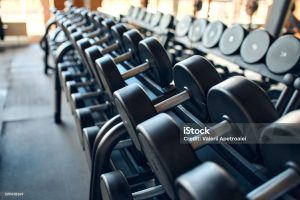Heavy or light weight for big muscles
Introduction
When you start going to the gym, one common dilemma you might face is whether to lift heavy weights or stick with lighter ones. This is a question many beginners ask, and it’s easy to understand why. As a novice lifter, you might walk into the gym and notice others pushing heavy weights with ease, making your lighter dumbbells seem inadequate. This can lead to the misconception that to build muscle, you must lift heavy from the start.
The tendency to imitate others in the gym is strong, especially when you’re surrounded by people who seem far more advanced. However, what often gets overlooked is the difference in individual capacity. Those lifting heavy weights may have spent years developing their strength and honing their technique. As a beginner, it’s crucial to recognize that your current strength level is different from those who have been training for years. Unfortunately, many people fall into the trap of comparison, trying to match the weights lifted by others without considering their own limitations. This approach is misguided and can lead to unnecessary strain or injury.

Ego lifting
You don’t need to lift excessively heavy weights to build muscle effectively. In fact, trying to match the weights lifted by others without considering your own capabilities can hinder your progress. It’s important to understand that while using heavy weights is necessary for muscle growth, “heavy” is relative and varies from person to person. What feels heavy for you might be light for someone else, and vice versa.
The concept of heavy lifting depends on several factors, including your training experience, body weight, height, and even gender. These factors contribute to the differences in strength and size among individuals in the gym. The most significant factor is the amount of time and effort you’ve invested in your training. Simply walking into the gym and attempting to lift the same weights as someone more experienced isn’t just unrealistic—it’s a misguided approach. Instead of ego-lifting, focus on gradually increasing the weights you lift, keeping your form and progress in mind.

Best strategy
The most effective approach in the gym begins with mastering the fundamentals of weightlifting. You won’t achieve significant muscle growth or safely lift heavier weights if you don’t first understand the correct techniques for each exercise. Start by learning the basics before gradually increasing the weights you lift. It’s crucial to understand how each exercise should be performed to avoid injury and maximize your gains.
Don’t hesitate to ask for help if you’re unsure about something. Being open to learning from others is a sign of strength, not weakness. There’s no harm in seeking advice from those who have already built a strong physique. Think of yourself as a sponge in the gym—absorb all the knowledge you can from experienced individuals. By focusing on proper form and continuously learning, you’ll set a strong foundation for long-term success in your fitness journey.

Mind muscle connection
There are countless online resources where you can find detailed instructions on how to perform various exercises. Watching these videos, conducting your own research, and seeking advice from those who have already achieved a well-built physique are all excellent ways to gather valuable knowledge. Applying this knowledge in the gym is crucial for your progress.
When you step into the gym, focus on mastering the basics—understand how to properly perform each exercise and how to truly engage your muscles, rather than just going through the motions of lifting weights. Developing a strong mind-muscle connection is key; it’s about feeling the muscle work during each movement. Once you’ve established this connection, you’ll find it much easier to make progress and gradually increase the weights you can lift. But before you can advance, it’s essential to lay the groundwork by thoroughly learning each exercise.

Myth about heavy weights
Beginners often assume that building muscle is as simple as lifting weights up and down, mimicking what they see others doing in the gym. However, this superficial understanding misses the essence of effective muscle building and proper exercise execution. Take the bicep curl, for example. It may look like you’re merely moving a dumbbell or barbell up and down, but the reality is far more nuanced.
Those who are experienced in the gym understand that muscle building isn’t just about the mechanical movement of weights. It’s about deeply engaging the muscle and feeling it work with each repetition. When you perform a bicep curl correctly, you’re not just lifting the weight—you’re concentrating on the muscle contraction, maintaining control throughout the entire movement, and ensuring that the muscle is fully activated. This mind-muscle connection is what differentiates effective exercise from merely going through the motions. To truly build muscle, you need to focus on quality movement and muscle engagement rather than just moving weights from point A to point B.

Take bicep curls, for example. When you’re performing this exercise, it’s not just about lifting the weight; it’s about engaging your mind and focusing on your biceps. You apply a mind-muscle connection by directing your mental focus to the muscle being worked. This involves keeping your entire body tight, maintaining a stiff core, and ensuring that the biceps are the primary muscles engaged in lifting the weight.
As you curl the weight, you’re transferring the load from your forearms to your biceps, intensifying the muscle engagement to effectively target and “burn” the muscle. This process is much more intricate than simply moving the weight up and down; it’s about feeling every part of the movement and fully understanding the mechanics involved. Developing this connection and technique is a crucial and deeply conceptual aspect of effective muscle building.

To build a strong physique, it’s essential to first learn how to establish a mind-muscle connection. While it may seem straightforward, mastering this technique is actually quite complex and challenging. This is one of the reasons why many people in the gym struggle to achieve significant muscle growth. They often seek quick results, thinking that simply moving weights up and down will be enough to build muscle. However, without a proper mind-muscle connection, they miss out on the deeper engagement needed for effective muscle development. This oversight is why many gym-goers never reach their full potential.
Important discussion
Whether you’re lifting weights, playing sports, or engaging in any other physical activity, progress requires time, effort, and dedication. The same principles apply to bodybuilding and weight training. To truly excel, you need to learn how to move the weight in a way that fully engages your muscles. Forget the idea that you can build muscle without putting in the necessary work, research, and knowledge.
If you’re new to lifting, which is likely if you’re wondering whether to lift heavy or light weights, it’s crucial to shift your focus away from how much weight you’re lifting right now. Instead, concentrate on building a solid foundation by learning how to perform exercises correctly. Many people in the gym never grasp the proper technique because they let their egos get in the way. They lift heavy weights without understanding the proper form, often just swinging the weights without feeling the muscle engagement. As a result, they fail to make real progress and struggle to build muscle effectively.
Don’t fall into that trap. If you want to see quick gains and build muscle efficiently, start by mastering the basics. Focus on the techniques that will set you up for long-term success in your muscle-building journey.

Once you’ve mastered proper technique, you’ll find it much easier to progress in your training. Take the bench press, for example. Instead of simply loading the bar and pressing it without engaging your muscles, focus on learning the correct form to avoid injuries and maximize your gains. If you rush into it without understanding the fundamentals, you risk injuring your shoulders, chest, or other parts of your body.
Start by learning how to engage the right muscles, retract your scapula, arch your back, and utilize leg drive. These foundational techniques are crucial for safely performing exercises and building muscle effectively. Once you’ve nailed the basics, you’ll discover that progressing in the gym becomes much more straightforward. For novice lifters, strength gains come quickly, and the muscle mass you can build in your first year will be substantial compared to the slower progress you’ll experience later. By laying a strong foundation, you’ll set yourself up for long-term success in your fitness journey.

After 4 to 5 years of lifting, the rate of progress in muscle growth will slow down significantly compared to the rapid gains you experience as a beginner. Take advantage of the initial phase of your training to maximize your gains while progress is quicker. To transition out of the novice phase effectively, focus on mastering proper techniques, learning from experienced individuals, and conducting thorough research.
Invest time in understanding and perfecting your form, whether by researching online, seeking advice from knowledgeable gym-goers, or hiring a coach. The more you learn and refine your approach, the more you can make the most of the early stages of your lifting journey. This foundational work will set you up for continued success as you advance and help you achieve the best possible results from your efforts.

Conclusion
Returning to the question of whether to lift light or heavy weights, it’s true that using the heaviest weights within your target rep range is often the most effective way to build muscle and strength. However, it’s crucial to emphasize that this should be done with proper form and without relying on momentum. Ideally, for muscle growth and strength, aim to lift the heaviest weight you can control within a rep range of about 8 to 12 reps.
Lifting very light weights with high repetitions isn’t optimal for building significant muscle and strength. Such a rep range is more suited to specific sports training, like boxing, where high-rep, light-weight exercises are used for endurance and specific conditioning. For general muscle building and strength, focus on a rep range of 8 to 10, or 7 to 12 reps, using a challenging weight that you can lift with good form.
Remember, this approach is most effective for those who have already learned proper exercise techniques. Beginners should first concentrate on mastering the correct form before progressing to lifting heavier weights.




